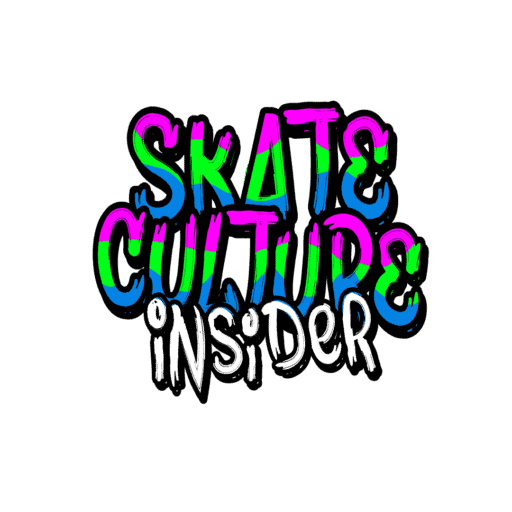- Best Starter Skateboards: Which is Right for Your Needs? - April 12, 2021
- Best Longboards for Cruising: How to Find The Right One - March 30, 2021
- Best Longboard Bearings: Top 10 Options - March 21, 2021
If you’ve decided to enter into the exciting world of skateboarding, congrats, and welcome! Skateboarding is far more than just another sport for most people and offers a brand-new way of seeing your surroundings — steps become an obstacle to conquer, a handrail becomes another challenge to slide down, and even simple curbs become a canvas for a variety of different tricks to learn.
Skateboarding is difficult and is thus an ideal way to build confidence and perseverance. You may try a trick 1000 times before you get it right, and the feeling of finally landing that kickflip or ollie is incredibly cathartic.
Not only that, and although skateboarding is not a team sport, it is largely a social sport and is a wonderful way to be a part of a unique community. Lastly, skateboarding is a great form of exercise and will help strengthen your legs and core.
With all the available options these days, it can seem overwhelming to choose the correct board as a beginner to skateboarding. In reality, however, it’s fairly simple, and there are some basics to stick to that will go a long way in helping you choose the right board.
In this article, we’ll look at some of the best skateboards for adults, as well as what to look for when buying your first board. Let’s get started!
Skateboards 101
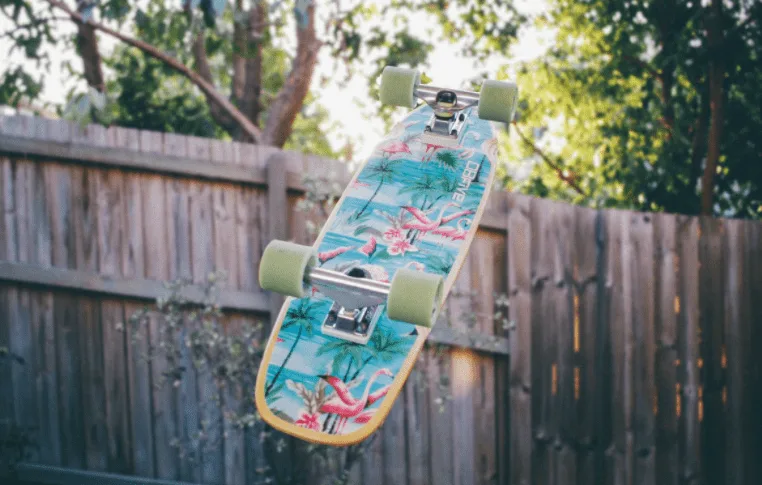
When buying your first skateboard, it’s important to note that a skateboard is made up of 4 basic components, each of which can be purchased with a whole setup or as separate parts that you can customize on your own. A complete skateboard consists of:
- A wooden deck (with griptape)
- Trucks
- Wheels
- Bearings
Decks
Almost all skateboard decks are made from maple, and occasionally bamboo or a combination of both. Maple is the perfect combination of strength and flexibility, and bamboo adds additional flexibility but is typically not as strong as maple.
Decks are usually made from 5-7 ply’s of laminated maple to add to their strength, and bamboo is occasionally sandwiched between a few layers of maple to add some strength.
Decks for adults are typically 7.5-inches to 8.5-inches wide, but for beginners, we recommend a happy medium of around 8-inches.
Narrower boards are ideal for technical skaters who like to flip their boards a lot whereas wider boards are more stable and easier to ride, but more difficult to perform technical tricks on. Modern decks have “kicks” on either side to allow you to pop the board for tricks and help with steering.
Trucks
Tracks are the metal T-shaped components that attach to your deck and hold the wheels and bearings. There are rubber “bushings” inside the trucks that allow for some shock absorption and make steering possible are held by a single bolt, or “kingpin”.
Trucks come fully assembled, however, and generally only vary in strength and quality of construction. Trucks are the most expensive component of your skateboard but also the longest-lasting, and so we recommend going for the best trucks you can afford if you’re buying components separately.
Wheels
Wheels come in a massive variety of sizes and durometers (hardness) depending on your needs. For street skating, you’re looking at sizes between 50-60mm, and larger — up to 100mm — for ramps, bowls, and general cruising.
Small wheels have quick acceleration and are lightweight, whereas larger wheels are smoother to ride and faster overall. In terms of durometer, around 70-80a is nice and grippy and ideal for cruising, and around 90a is great from the street.
Bearings
Bearings fit inside your skateboard wheels and allow them to turn smoothly. They are measured in ABEC ratings, typically from 1-9.
For beginners, a rating of ABEC 7 is ideal, but even lower ratings are fine and will do the trick. Higher ABEC ratings are usually of higher quality and thus longer-lasting, but in the beginning, even lower ratings will still be perfect to get you going.
ABEC ratings used to be the go-to for measuring how good bearings are, but it turns out that is not the case, and a set of classic Bones Redz are the go-to for beginners and professionals.
Other Considerations:
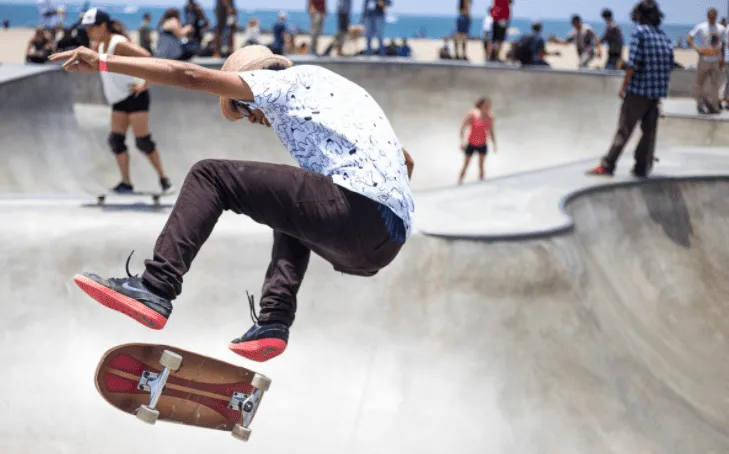
Apart from these four basic components, there are several other small considerations that make up a complete skateboard too. These include:
- Griptape. Griptape is the black (usually), sandpaper-like surface on the top of your board that helps keep your feet from slipping off your board. A complete deck will usually come with grip tape already applied to the board, but when buying a separate deck, you’ll need to apply it yourself. There is a wide variety of custom printed grip tape available these days, but standard black grip tape will do the job fine too.
- Riser Pads. Unless you are using fairly large wheels and want to prevent wheel bite, riser pads are not really necessary, although they do provide a tiny bit of shock absorbance. Riser pads are placed between your deck and truck’s baseplate, and also may help prevent cracks from heavy impact. They are super cheap, so it won’t hurt to give them a go.
- Bushings. Standard bushings that come with your trucks are ideal for beginners, and you shouldn’t need to worry much about them. Soft bushings will allow for sharper turning, whereas hard bushings offer more stability.
The Best Skateboards for Beginner Adults — Our Reviews
Now that you have a basic idea of what components make up a complete skateboard, it’s time to choose one! The following boards are our top choices and are all complete setups, which we highly recommend for beginners.
Buying a complete setup is a lot easier and will allow you to skate immediately without the hassle of setting up aboard. Let’s dive in!
1. Powell-Peralta Complete — Best Overall
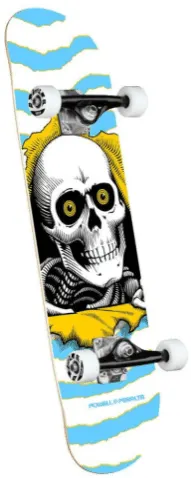
Powell Peralta has long been one of the biggest names in skateboarding, and when you buy a Powell Peralta you know you’re getting quality you can trust.
The company has some of the most iconic graphics in the industry paired with outstanding manufacturing and industry knowledge.
The Powell “Ripper” Complete has a 7.5-inch maple deck, 90A, 53mm wheels, and Mini Logo trucks, bearings, and hardware. The Ripper graphic is one of the most iconic skateboard graphics of all time and has been one of the staple images of Powell Peralta for the last 30 years.
Pros
- Iconic graphics
- 8-ply maple deck
- 90A wheels
- Outstanding brand reliability
Cons
- Standard issue wheels and bearings
2. CCS Natural Complete — Best for street
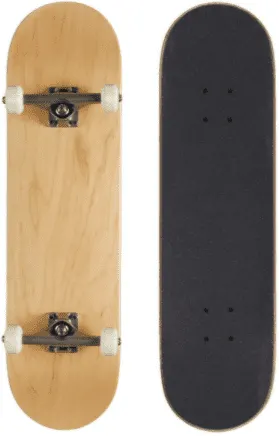
Street skating is notoriously hard on your board, even as a beginner and your pristine graphic will soon be reduced to blurry, scratched colors.
The CCS Natural complete solves this by giving you a board with a completely natural, wood finish that leaves an open canvas for you to decorate with stickers and street scars!
The complete features 52mm, 100a wheels, raw silver trucks, ABEC 7 bearings, and your choice of 7-inch to 8.5-inch deck width. Plus, the board comes with a CCS skate tool included!
Pros
- Quality maple deck
- Hard wheels ideal for street
- Beautiful natural finish
- ABEC 7 bearings
- CCS skate tool included
Cons
- Plain-looking deck
- Trucks are of low quality
3. Cal 7 Complete — Best budget option
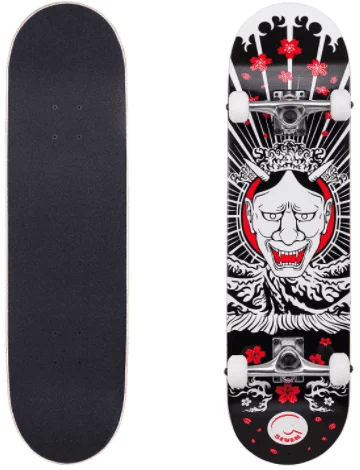
If you are ready to get skating but don’t want to outlay too much cash initially, This Cal 7 Complete is the ideal choice if you are on a budget, offering decent quality components for half the price of other brands.
The deck comes in a massive variety of different graphics, plus a range of deck widths from 7.5-8 inches. The setup features a 7-ply maple deck, 5.2-inch aluminum trucks, ABEC 7 bearings, and 52mm, 100a urethane wheels, all with a 1-year warranty. Plus, the board comes to set up and ready to shred!
Pros
- Inexpensive
- Wide range of graphic options
- 7-ply maple deck
- ABEC 7 bearings
Cons
- Bushings are very soft
- Standard issue bearings are low quality
4. Magneto Mini Cruiser — Best for cruising
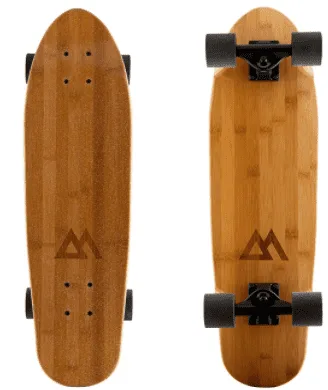
This super portable Cruiser from Magneto is the ideal option for cruising the streets, but still has a hefty enough tail kick to perform tricks and ollie up curbs too.
It features a 5-ply maple and 2-ply bamboo combination deck with a beautiful wood finish that is further enhanced by transparent grip tape. The deck is 7.5-inches wide and 27.5 inches long, with soft 78A wheels that are 60mm in diameter with a 51mm contact patch.
The short scale length, large, soft wheels, and asymmetrical design make for a comfortable ride to cruise the streets and still pop a few ollies and manuals. Some customers report the bamboo and maple plies separating, though, which is disappointing.
Pros
- Cruiser/street capability
- Maple and bamboo combination 7-ply deck
- 60mm, 78a wheels
- Transparent grip tape and striking wood finish
Cons
- Wood tends to separate
- Low-quality hardware
5. Minority Downhill Maple — Best for downhill
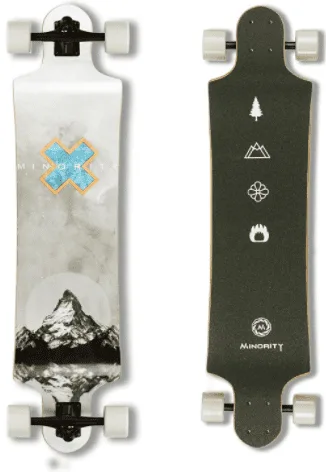
If your vibe is more fast speeds down long hills, a longboard may be what you’re looking for. The 40-inch drop deck longboard from Minority is a capable downhill board at a highly affordable price and has all the features you need for screaming down a hill at high speeds.
The board features an 8-ply, spacious 10-inch width, 100% maple deck, 7-inch aluminum reverse kingpin trucks, 70mm, 78a polyurethane wheels, ABEC 9 bearings, and killer graphics to top it off. This is a board built for speed but offers enough stability and versatility to cater to beginners too.
Pros
- Drop deck design
- 8-ply 100% maple deck
- 7-inch reverse kingpin trucks
- ABEC 9 bearings
- 70mm urethane wheels
Cons
- Very flexible and bottoms out quickly
- Low-quality deck construction
Alternatives
5. Blind Complete street board

Blind Skateboards have long been a major player in the world of street skating, and the company makes some of the best skateboards in the industry.
The Blind Complete Skateboard features an 8.125-inch, 7-ply maple deck with the iconic Blind logo, Tensor trucks, Blind 92a 52mm wheels, and tough Blind hardware.
6. Almost Complete Skateboard

This complete skateboard from Almost comes setup and ready to ride right out of the box. The deck is made from 7 plies of Hardrock maple glued together with extra stiff glue for long-lasting strength and extra pop, carbon steel speed bearings, and Almost wheels and trucks.
7. Minority Complete Skateboard
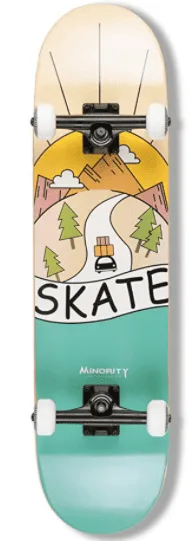
Minority makes some high quality yet affordable skateboards and longboards that are ideal for beginners.
This complete setup features a 7-ply, 8-inch, Hardrock maple deck, aluminum alloy trucks with a carbon steel kingpin and high rebound bushings, ABEC 9 bearings, and 52mm 100a urethane wheels. You won’t get much better quality for the price than Minority Skateboards.
FAQs
Answer: There is a ton of misleading information about the right size skateboard, to begin with, and the only measurement you really need to pay attention to is the width.
Street skateboards commonly come in widths between 7.5-inches and 8.5-inches, and every skater has their preference. A lot of people will tell you to go for a width based on your shoe size, but this is untrue and not based on fact.
The truth is that the narrower your skateboard, the easier it is to flip and perform tricks. A wider deck will give you more stability but make it harder to flip.
So, if you are a beginner that is looking to get into performing tricks, choosing a wider board according to your shoe size will make tricks harder and may lead to extreme frustration. If you are looking more at just cruising on-ramps, however, a wider board may be better as it offers more stability.
For beginners, we usually recommend a board of around 8-inches wide, to begin with, and then go from there. But it also depends on your unique desire and aspirations for skating.
Answer: Skateboarding can be as easy or as difficult as you want, depending on what you want to achieve. The fundamentals of standing, pushing, and turning are easy though, and you should be pretty proficient after only a few weeks. Ride your board as much as you can until you feel completely comfortable before you begin learning tricks, as this is where it can get difficult.
Getting the basics down is not difficult, and contrary to popular belief, you can start skateboarding at any age!
Answer: Yes, most definitely. If your board is too long, you’ll find it difficult to maneuver, and if it’s too short it will feel unstable.
Typically, street boards are all roughly the same length and only differ in width, as discussed above. For beginners that are tall with large feet, a narrow board may make them feel too unstable while riding, whereas for beginners who want to learn loads of tricks a super wide board may feel heavy and clunky and difficult to flip.
Remember that there are different skateboards for different purposes. Longboards are purely for going fast speeds downhill, street boards are for tricks and ramps, and hybrid “cruiser” boards are the best of both worlds.
Final Thoughts
While it can get confusing to choose the right board as an adult beginner with all the available options, picking a good skateboard is a simple process once you know what to look for. We recommend going for a complete setup in the beginning so you can get out and ride as soon as possible, but buying components separately has its advantages too.
Hopefully, our guide and in-depth reviews have helped clear out some confusion, so you can get out skateboarding today!
